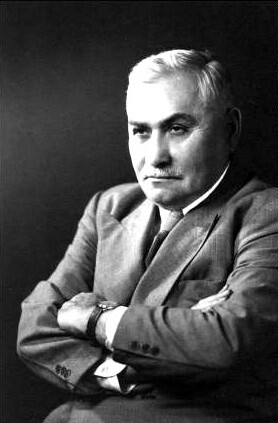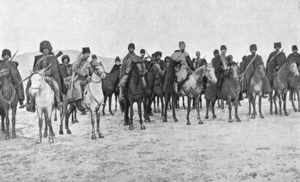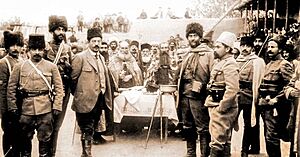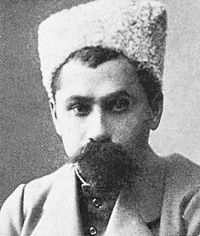Drastamat Kanayan facts for kids
Quick facts for kids
Drastamat Kanayan
Դրաստամատ Կանայեան |
|
|---|---|
 |
|
| Defense Minister of Armenia | |
| In office 24 November 1920 – 2 December 1920 |
|
| Preceded by | Ruben Ter-Minasian |
| Succeeded by | position abolished |
| Civil Commissioner of Van | |
| In office December 1917 – 7 April 1918 |
|
| Preceded by | position established |
| Succeeded by | position abolished |
| Personal details | |
| Born | 31 May 1884 Igdyr (Iğdır), Surmalu uezd, Erivan Governorate, Russian Empire |
| Died | 8 March 1956 (aged 71) Boston, Massachusetts, United States of America |
| Nationality | Armenian |
| Political party | Armenian Revolutionary Federation |
| Nickname | General Dro |
| Military service | |
| Allegiance | |
| Years of service | 1914–1920 1941–1945 |
| Commands | 2nd Battalion Volunteer Corps Armed Forces of Yerevan 812th Armenian Battalion |
| Battles/wars | Armenian National Liberation Movement Armenian–Azerbaijani war Muslim uprisings in Kars and Sharur–Nakhichevan |
Drastamat Kanayan (Armenian: Դրաստամատ Կանայեան; born May 31, 1884 – died March 8, 1956) was an important Armenian military leader and politician. He was often called Dro (Դրօ). He was a member of the Armenian Revolutionary Federation, a political party.
For a short time in 1920, he served as the Defence Minister of the First Republic of Armenia. This was when Armenia was an independent country. During World War II, he led the Armenian Legion. This group was made up of Armenian prisoners of war. They chose to fight for Nazi Germany instead of facing harsh conditions in the prison camps.
Contents
Early Life and Becoming a Leader
Drastamat Kanayan was born in 1884 in a place called Igdyr, which is now in Turkey. His father, Martiros Kanayan, was a leader of their family group. Young Drastamat was more interested in military exercises than school. He loved visiting the army barracks in Igdyr, which was a big military post.
His father saw that Drastamat didn't like books. So, he sent him to a different school in Yerevan. Even there, Drastamat's grades were just enough to pass. At that time, Russian schools tried to make everyone speak Russian. They only allowed Armenian language for religious studies.
Drastamat was inspired by stories of General Andranik, another Armenian hero. He also learned about Armenian nationalism. He joined a secret youth group at his school. This group was against the Russian government and supported Armenian independence.
Fighting for Armenian Rights
In 1903, the Russian government tried to take control of all Armenian Church property. Armenians saw this as a threat to their identity. Drastamat joined the Armenian Revolutionary Federation to protect the churches. He helped organize protests and guarded the churches.
In 1905, he used a bomb to kill the governor of Baku, Prince Mikhail Nakashidze. The Armenian Revolutionary Federation believed the governor caused attacks against Armenians. Drastamat also helped organize Armenian defense groups during conflicts between Armenians and Tatars from 1905 to 1907. In 1907, he killed another Russian general named Maksud Alikhanov.
World War I Hero
During World War I, Drastamat Kanayan served in the Russian Caucasus Army. He was a commander of Armenian volunteer groups. The Tsar, Russia's emperor, even gave him an award.
In November 1914, he led the second battalion of Armenian volunteers. They fought their first battle near Bayazid. Drastamat was badly wounded in this fight. He was in critical condition for months. But his battalion kept fighting in many battles.
After he recovered, he returned to lead his soldiers. He became a very popular military leader. This was because of his victories against the Ottoman Empire in the Caucasus Campaign.
In 1918, he was made a military leader for the Ararat region. He commanded Armenian forces in the Battle of Bash Abaran. Armenian victories at Bash Abaran, Karakilisa, and Sardarabad were very important. They stopped the Ottoman Army from destroying the Armenian nation. These victories also helped create the First Republic of Armenia.
Leading the First Republic of Armenia
Dro was one of the main military commanders of the First Republic of Armenia. He led Armenian forces during a short war with Georgia in December 1918. This war was over disputed areas like Lori and Akhalkalaki.
Armenian–Azerbaijani War
For much of 1919, Dro and his army fought against Muslim rebels. These rebels were supported by the Ottoman Empire and Azerbaijan. Dro defended the area south of Yerevan. In December 1919, Dro went to Goris with 600 soldiers. His goal was to bring the Syunik and Nagorno-Karabakh regions under Armenian control. These areas were strongly disputed with Azerbaijan.
Dro, along with other commanders like Garegin Nzhdeh, quickly drove out the Azerbaijani army. They also moved most of the Turkic-speaking Muslims out of Syunik. This helped Armenia control the region.
In March 1920, Armenians in Artsakh revolted. Many people were killed, and thousands of houses were burned. The city of Shushi lost most of its Armenian population. Dro arrived in Artsakh in April, after many villages were already destroyed.
On April 27, 1920, the Red Army invaded Azerbaijan and set up a Soviet government. The Red Army leaders told Dro to leave Artsakh and Syunik. Dro knew that if he didn't, the Red Army and Azerbaijan's forces would attack Armenia. He left Artsakh after being promised a fair solution for the Artsakh conflict.
In July 1920, Dro and the Minister of Defence led a campaign against Muslim rebels. These rebels were supported by the Ottoman Empire and Azerbaijan. They fought in the Vedibasar and Zangibasar areas. Armenian refugees were then settled in the villages the rebels had left.
In August 1920, Dro's forces fought against the Red Army. The Red Army was trying to move into Syunik. Dro had some early success, but he was forced to leave Goris and move to Daralayaz.
Turkish–Armenian War and Soviet Control
On September 24, 1920, the army of Kâzım Karabekir invaded Armenia. Dro commanded the defense of his home district, Surmalu. He successfully defended Surmalu. However, the fall of Kars and the advance of Karabekir's army forced Dro's army to retreat. They crossed the Arax River into modern-day Armenia on November 12.
From November 24 to December 2, 1920, Kanayan was the Defence Minister of Armenia. On November 30, 1920, Soviet Russia told Armenia to peacefully hand over power to a Soviet government. Dro was given permission to talk with the Soviet representative, Boris Legran. He was to discuss the terms of this power transfer.
Dro ordered the Armenian army not to fight the Red Army if it entered Armenia. He signed the declaration that handed power to a Soviet government on December 2, 1920. This declaration also made Dro the temporary leader of Armenia until the new Soviet leaders arrived.
Dro stayed in Armenia and remained commander of Soviet Armenia's army until January 1921. Then, he was sent to Russia with 1,200 Armenian officers. He stayed in Moscow until 1923. After traveling in Europe, he settled in Bucharest, Romania in 1925. Dro's second wife, Arpenik, and their two children were sent to Siberia. They remained separated from him for the rest of his life.
World War II Involvement
During World War II, Dro was one of several members of the Armenian Revolutionary Federation who talked with Nazi Germany. They hoped that if Germany won the war against the Soviet Union, Armenia could become free from Soviet control.
The Armenian Legion was created from Armenian prisoners of war in Nazi camps. These prisoners chose to fight for Germany rather than face the terrible conditions in the camps. The Legion was placed under Dro's command. German army officers trained the Legion. They took part in the occupation of the Crimean Peninsula and the Caucasus.
Some historians say that about 18,000 Armenians served in the German armed forces during the war. After World War II ended, American forces arrested Drastamat Kanayan. However, he was soon released.
After the war, Kanayan moved to the United States. He continued his political work. In 1947, at a big meeting of the Armenian Revolutionary Federation, he was forgiven for his actions during the war. He was again chosen as a member of the party.
Later Life and Legacy
Dro settled in Beirut, where many Armenians lived. He lived there for several years with Simon Vratsian, a former prime minister of the First Republic of Armenia. He returned to the United States several times for medical treatment.
Dro died in Boston, Massachusetts on March 8, 1956, while getting medical care. He was buried there. He was survived by his third wife, Gayane, their son Mardiros, and his stepdaughter Olga.
On May 28, 2000, his remains were brought back to Armenia for burial in Aparan. This day was also the 82nd anniversary of the First Republic of Armenia.
In 2001, the Ministry of Defence of Armenia created the Drastamat Kanayan medal. This medal is given to military members and civilians who do very well in military training. In 2005, the Armenian government founded the Drastamat Kanayan Institute for National Strategic Studies. A street in Yerevan is also named after Dro.
Images for kids
-
Dro's grave in Mount Auburn Cemetery, Watertown, Massachusetts (before being moved to Armenia)
-
Dro's bust in Gyumri
See also
 In Spanish: Drastamat Kanayan para niños
In Spanish: Drastamat Kanayan para niños









